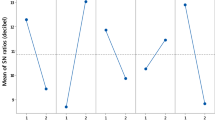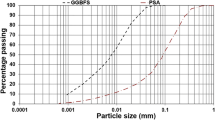Abstract
Purpose
Stabilisation/solidification (S/S) has emerged as an efficient and cost-effective technology for the treatment of contaminated soils. However, the performance of S/S-treated soils is governed by several intercorrelated variables, which complicates the optimisation of the treatment process design. Therefore, it is desirable to develop process envelopes, which define the range of operating variables that result in acceptable performance.
Methods
In this work, process envelopes were developed for S/S treatment of contaminated soil with a blend of hydrated lime (hlime) and ground granulated blast furnace slag (GGBS) as the binder (hlime/GGBS = 1:4). A sand contaminated with a mixture of heavy metals and petroleum hydrocarbons was treated with 5%, 10% and 20% binder dosages, at different water contents. The effectiveness of the treatment was assessed using unconfined compressive strength (UCS), permeability, acid neutralisation capacity and contaminant leachability with pH, at set periods.
Results
The UCS values obtained after 28 days of treatment were up to ∼800 kPa, which is quite low, and permeability was ∼10−8 m/s, which is higher than might be required. However, these values might be acceptable in some scenarios. The binder significantly reduced the leachability of cadmium and nickel. With the 20% dosage, both metals met the waste acceptance criteria for inert waste landfill and relevant environmental quality standards.
Conclusions
The results show that greater than 20% dosage would be required to achieve a balance of acceptable mechanical and leaching properties. Overall, the process envelopes for different performance criteria depend on the end-use of the treated material.








Similar content being viewed by others
References
Akinmurusu JO (1991) Potential beneficial uses of steel slag wastes for civil engineering purposes. Resour Conserv Recy 5(1):73–80. doi:10.1016/0921-3449(91)90041-L
Al-Tabbaa A, Stegemann JA (eds) (2005) Stabilisation/solidification treatment and remediation. In: Proceedings of the international conference. Taylor and Francis, London
ASTM D 1633-00 (2002) Standard method for compressive strength of molded soil–cement cylinders. American Society for Testing of Materials, West Conshohocken
ASTM D 5084-03 (2003) Standard test methods for measurement of hydraulic conductivity of saturated porous materials using a flexible wall permeameter. American Society for Testing of Materials, West Conshohocken
Barth E, Sass B, Chattopadhyay S (2007) Evaluation of blast furnace slag as a means of reducing metal availability in a contaminated sediment for beneficial use purposes. Soil Sediment Contam 16(3): 281–300. doi:10.1080/15320380701285683
British Standards Institution BS 1377: Part 4 (1990) Methods of test for soils for civil engineering purposes: compaction-related tests. British Standards Institution, London
Chirenje T, Rivero C, Ma LQ (2002) Leachability of Cu and Ni in wood ash-amended soil as impacted by humic and fulvic acid. Geoderma 108:31–47. doi:10.1016/S0016-7061(02)00120-9
Christensen TH, Lehmann N, Jackson T, Holm PE (1996) Cadmium and nickel distribution coefficients for sandy aquifer materials. J Contam Hydrol 24:75–84. doi:10.1016/0169-7722(96)00012-5
Conner JR (1990) Chemical fixation and solidification of hazardous wastes. Van Nostrand Reinhold, New York
Conner JR, Hoeffner SL (1998) A critical review of stabilization/solidification technology. Crit Rev Env Sci Technol 28(4):397–462. doi:10.1080/10643389891254250
El-Rawi MN, Awad AAA (1981) Permeability of lime stabilized soils. J Trans Eng Div ASCE 107:25–35
Environment Agency Guidance (2006) Guidance for waste destined for disposals in landfills, version 2, interpretation of the waste acceptance requirements of the landfill (England and Wales) regulations (as amended). http://www.environment-agency.gov.uk/. Accessed 27 Sept 2010
Environmental Protection Service (1984) Manual for spills of hazardous materials. Cat. No. EN40-320/1984E. Environmental Protection Service, Environment Canada, Ottawa
Förstner U (2007) Environmental quality standards (EQS) applicable to sediment and/or biota. J Soils Sediments 7(4):270. doi:10.1065/jss2007.07.240
Halim CE, Amal R, Beydoun D, Scott JA, Low G (2003) Evaluating the applicability of a modified toxicity leaching procedure (TCLP) for the classification of cementitious wastes containing lead and cadmium. J Hazard Mater B103:125–140. doi:10.1016/S0304-3894(03)00245-0
Halim CE, Amal R, Beydoun D, Scott JA, Low G (2004) Implications of the structure of cementitious wastes containing Pb(II), Cd(II), As(V), and Cr(VI) on the leaching of metals. Cement Concrete Res 34:1093–1102. doi:10.1016/j.cemconres.2003.11.025
Higgins DD (2005) Soil stabilisation with ground granulated blastfurnace slag. UK Cementitious Slag makers Association report. http://www.ecocem.ie/downloads/Soil_Stabilisation.pdf?PHPSESSID=5ec729224273596073a6071e4f56075d. Accessed 27 Sept 2010
Kogbara RB, Al-Tabbaa A (2011) Mechanical and leaching behaviour of slag-cement and lime-activated slag stabilised/solidified contaminated soil. Sci Total Environ (in press). doi:10.1016/j.scitotenv.201
LaGrega MD, Buckingham PL, Evans JC, Environmental Resources Management (2001) Hazardous waste management, 2nd edn. McGraw Hill, New York
Nidzam RM, Kinuthia JM (2010) Sustainable soil stabilisation with blastfurnace slag: a review. Proc Instn Civ Engrs Construction Materials 163(3):157–165. doi:10.1680/coma.2010.163.3.157
Paria S, Yuet PK (2006) Solidification/stabilization of organic and inorganic contaminants using portland cement: a literature review. Environ Rev 14:217–255. doi:10.1139/A06-004
Piratheepan J, Gnanendran CT, Lo SCR (2010) Characterization of cementitiously stabilized granular materials for pavement design using unconfined compression and IDT testings with internal displacement measurements. J Mater Civ Eng 22(5):495–505. doi:10.1061/(ASCE)MT.1943-5533.0000051
Schifano V, Macleod CL, Dudeney AWL, Dudeney R (2005) Remediation of soils contaminated with petroleum hydrocarbons using quicklime mixing. In: Al-Tabbaa A, Stegemann JA (eds) Stabilisation/solidification treatment and remediation. Proceedings of the international conference. Taylor and Francis, London, pp 69–78
Shi C, Spence R (2004) Designing of cement-based formula for solidification/stabilisation of hazardous, radioactive, and mixed wastes. Crit Rev Env Sci Technol 34(4):391–417. doi:10.1080/10643380490443281
Spence RD, Shi C (eds) (2005) Stabilization and solidification of hazardous, radioactive and mixed wastes. CRC, Boca Raton
Stegemann JA, Côté PL (1991) Investigation of test methods for solidified waste evaluation—cooperative program. Environment Canada Report EPS 3/HA/8, Ottawa, Ontario
Stegemann JA, Zhou Q (2008) Development of process envelopes for cement-based stabilisation/solidification of metal treatment filtercakes. In: Zamorano M, Popov V, Kungolos AG, Brebbia CA, Itoh H (eds) Waste management and the environment IV, WIT transactions on ecology and the environment, vol. 109. WIT, Southampton, pp 21–30
United States Environmental Protection Agency (1986) Prohibition on the disposal of bulk liquid hazardous waste in landfills—statutory interpretive guidance. Office of Solid Waste and Emergency Response (OSWER) Policy Directive No. 9487.00-2A, EPA/530-SW-016, Washington, DC
Van der Sloot HA, Comans RNJ, Meeussen JCL, Dijkstra JJ (2003) Leaching methods for soil, sludge and treated biowaste. ECN Environmental Risk Assessment, Draft version 2. Available: http://www.ecn.nl/docs/society/horizontal/hor_desk_23_leaching2.pdf
Van Gerven T, Cornelis G, Vandoren E, Vandecasteele E, Garrabrants AC, Sanchez F, Kosson DS (2006) Effects of progressive carbonation on heavy metal leaching from cement-bound waste. AIChE J 52(2):826–837. doi:10.1002/aic.10662
Vreysen S, Maes A (2005) Remediation of a diesel contaminated, sandy-loam soil using low concentrated surfactant solutions. J Soils Sediments 5(4):240–244. doi:10.1065/jss2005.10.146
Wild S, Kinuthia JM, Robinson RB, Humphreys I (1996) Effects of ground granulated blastfurnace slag (GGBS) on strength and swelling properties of lime stabilized kaolinite in the presence of sulphates. Clay Miner 31(3):423–433
Acknowledgement
This paper was written to support the ProCeSS project, which was conducted by a consortium of five universities, led by University College London, and 17 industrial partners, funded through the UK Technology Strategy Board (ProCeSS, Project No: TP/3/WMM/6/I/15611), which is sponsored by the Department for Innovation, Universities and Skills. The project website is at http://www.cege.ucl.ac.uk/process. The authors thank Dr. Martin Liska for providing data on the solubility profiles of the heavy metals.
Author information
Authors and Affiliations
Corresponding author
Additional information
Responsible editor: Hailong Wang
Rights and permissions
About this article
Cite this article
Kogbara, R.B., Yi, Y. & Al-Tabbaa, A. Process envelopes for stabilisation/solidification of contaminated soil using lime–slag blend. Environ Sci Pollut Res 18, 1286–1296 (2011). https://doi.org/10.1007/s11356-011-0480-x
Received:
Accepted:
Published:
Issue Date:
DOI: https://doi.org/10.1007/s11356-011-0480-x




